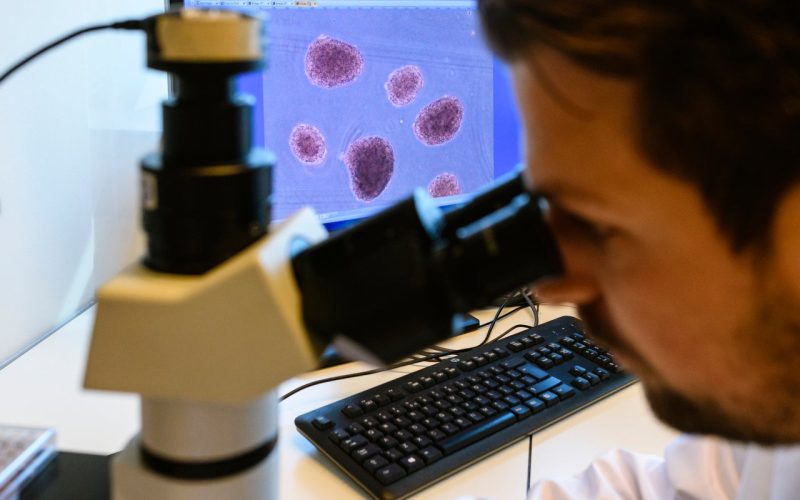Researchers at UMC Utrecht are starting three innovative cancer studies with organoids. These are a kind of ‘mini-organs’, destined to make an important contribution to the personalisation of cancer treatments. The projects are made possible by KWF Dutch Cancer Society, which has granted the researchers almost 1.6 million euros in total.
Organoids are grown in a laboratory. They can mimic all kinds of organs, but also tumours. These 3D miniature organs have revolutionised cancer research: previously, researchers could only work with 2D models of cancer cells. Tumour organoids preserve the unique characteristics of a patient’s tumour. They are therefore well suited to test and develop (new) treatments.
Three cancer researchers have now received KWF grants to carry out their projects with organoids. Jeanine Roodhart is going to use the mini-organs to improve anal cancer treatment. Martijn Gloerich is going to investigate how colon cancer cells change when they metastasise. And Boudewijn Burgering is focusing on a new technique to prevent resistance to cancer drugs. Read more about their projects below.
Every year, around 300 people are diagnosed with anal cancer in the Netherlands. Treatment consists of a combination of radiotherapy and chemotherapy. This is an intense process, and many patients suffer from side effects. With one in five patients, this combination treatment is not sufficient, making surgery still a necessity.
Medical oncologist and associate professor Jeanine Roodhart is dedicated to making the combination treatment as effective as possible for each anal cancer patient. That is, she would like to make the therapy powerful enough to ensure the patient will survive the disease, preferably without surgery. At the same time, she would like to avoid administering doses that are too high, preventing side effects from happening. She also would like develop new treatments for patients for whom current treatment is still inadequate. From KWF, she will receive almost 690,000 euros to realise her research.
Jeanine will develop tumour organoids for 62 anal cancer patients. “It is important that each organoid actually resembles the anal tumour on which it is based,” she explains. “By comparing the cells and DNA of the tumour and the organoid before and after treatment, we will be able see whether the treatment has the same effect on the organoid as on the tumour.”
If the organoid model works sufficiently, it could be used to test the treatment in advance and develop new cures with it. In the future, Jeanine would like to make an organoid for every patient, so that everyone with anal cancer will receive the best treatment. Jeanine: “This way, we will increase the chance that new treatments will be effective and work towards a tailor-made cure for every patient.”
Colon cancer is one of the most common cancers: every year, 12,000 people are diagnosed with the disease in the Netherlands. There are, however, still no perfect ways to treat metastatic colon cancer, decreasing the survival rates. Cell biologist and associate professor Martijn Gloerich would like to figure out precisely how colon cancer cells metastasise. “Then, colon cancer treatments could be made more effective in the future,” he says.
Colon tumours mainly grow because of so-called ‘cancer stem cells’. Martijn: “We already know that these cancer stem cells play a role in colon cancer metastases. But the cells that detach from the colon tumour and finally metastasise are actually not cancer stem cells. That is, they are shape-shifting cancer cells: they behave like very young intestinal cells that we normally only encounter before birth, during the development of the intestines. Once those cancer cells in disguise have found a place to metastasise (often in the liver), they change shape again. Then, they become cancer stem cells, stimulating the metastasis process. This significantly decreases the patient’s chance of survival.”
With a KWF grant of almost 665,000 euros, Martijn wants to find out how this shape- shifting take place and which parts of the cancer cells are involved. To do this, he uses organoids resembling colon tumours. Martijn: “By using organoids, we will be able to mimic the interaction between cancer cells and their environment, which is important to understand how cancer cells behave and metastasise.”
Previous research by Martijn’s research group already showed that communication between (cancer) cells and their environment plays an important role here. Martijn is now looking for ways to be able to interfere with these processes at the cellular level: “This way, we will stop, or even prevent, colon cancer from metastasising.”
In a tumour, cancer cells are not alike. They often consist of different types of cells, each with its own abnormalities. This is usually the reason why a certain medicine does not work, or the tumour becomes resistant to it. Resistance occurs when the drug is effective at first, but at some point stops working.
How cancer cells exactly become resistant to drugs is quite unclear. Boudewijn Burgering, professor of signal transduction and molecular cancer researcher, is keen to find out. From KWF, he has now received over 245,000 euros for his research.
With his research group, Boudewijn uses a new technique: single cell proteomics. This allows him to see which proteins are present in each individual cancer cell, and how these proteins differ between cancer cells within one tumour. By doing so, Boudewijn aims to detect the proteins that cause resistance to cancer drugs.
“Knowing which proteins we need to target to make a medicine effective could make a big difference in cancer treatment,” Boudewijn explains. “For this, we use organoids that resemble a tumour. We will also film how these organoids are growing. With cancer, something often goes wrong with the distribution of DNA among daughter cells during cell division. What we don’t know is how this affects the proteins in the cells. By keeping a close eye on the organoids, we will witness how cancer cells divide, and which proteins are and are not passed on during cell division. This knowledge will also enhance our understanding of how tumours become resistant to drugs.”
